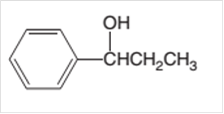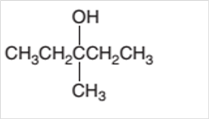
Concept explainers
(a)
Interpretation:
The dehydrate product formed from following alcohol with

Concept Introduction:
A
In a chemical reaction, the substance which is involved in conversion is said to be a reactant, whereas the newly formed substance is known as a product. Both reactants and products must be separated by an arrow.
A dehydration reaction is an elimination reaction in which a water molecule eliminates from alcohol to form
(b)
Interpretation:
The dehydrated product formed from the following alcohol with

Concept Introduction:
A chemical reaction is the symbolic representation of the conversion of substances to new substances.
In a chemical reaction, the substance which is involved in conversion is said to be reactant whereas the newly formed substance is known as a product. Both reactants and products must be separated by an arrow.
A dehydration reaction is an elimination reaction in which a water molecule eliminates from alcohol to form alkene in the presence of
(c)
Interpretation:
The dehydrated product formed from the following alcohol with

Concept Introduction:
A chemical reaction is the symbolic representation of the conversion of substances to new substances.
In a chemical reaction; the substance which is involved in conversion is said to be reactant whereas the newly formed substance is known as a product. Both reactants and products must be separated by an arrow.
A dehydration reaction is an elimination reaction in which a water molecule eliminates from alcohol to form alkene in the presence of
(d)
Interpretation:
The dehydrate product formed from the following alcohol with

Concept Introduction:
A chemical reaction is the symbolic representation of the conversion of substances to new substances.
In a chemical reaction, the substance which is involved in conversion is said to be reactant whereas the newly formed substance is known as a product. Both reactants and products must be separated by an arrow.
A dehydration reaction is an elimination reaction in which a water molecule eliminates from alcohol to form alkene in the presence of
Want to see the full answer?
Check out a sample textbook solution
Chapter 14 Solutions
EBK GENERAL, ORGANIC, & BIOLOGICAL CHEM
- Draw the products formed when each alcohol undergoes dehydration with TsOH, and label the major product when a mixture results.arrow_forwardDraw the products formed when each alcohol is dehydrated with H 2SO 4.arrow_forwardWhich of the following alcohols is the MOST soluble in water? O 2-methyl-2-pentanol O 4-methyl-2-pentanol O 3-methyl-1-butanol O 2-methyl cyclohexanolarrow_forward
- Predict which member of each group is most soluble in water, and explain the reasons for your predictions. phenol, cyclohexanol, or 4-methylcyclohexanolarrow_forwardDraw the products formed when attached alcohol undergoes dehydration with TsOH, and label the major product when a mixture results.arrow_forwardClassify each alkyl halide as 1 °, 2 °, or 3 °.arrow_forward
- Describe chemical properties of alcohols (intermolecular dehydration, intramolecular dehydration).arrow_forwardDraw the eight constitutional isomers with molecular formula C5H120 that contain an OH group. Give the IUPAC name for each compound. Classify each alcohol as 1°, 2°, or 3°.arrow_forwardName the following alcohol. O2-Bromo-4-ethylcyclopentanol 4-Ethyl-2-bromocyclopentanol O1-Ethyl-3-bromo-4-cyclopentanol O1-Bromo-4-ethyl-2-cyclopentanolarrow_forward
- Organic Reaction Write an equation for the oxidation of each alcohol. Use [O] above the arrow to indicate an oxidizing agent. If no reaction occurs, write "no reaction" after the arrow. 1. CH3CH2CH2CH2CH2OH CH₂ CH₂CCH₂CH₂ ОН CH CHCH CH CH CH, ОНarrow_forwardLabel each ether and alcohol in brevenal, a marine natural product. Classify each alcohol as 1°, 2°, or 3°.arrow_forwardCH,CH,CH,-OH Draw the structure of the product expected when each of the following alcohols is reacted with a sulfuric acid catalyst au the temperature indicated. H,SO, CH,-CH-CH, 180°C a. OH H,SO, CH, — CH—СH,—ОН 180°C b. CH; H,SO, CH-CH-OH 140°C с. CH, CH,-CH-CH,-CH, H,SO, d. 140°C d. OHarrow_forward
 Chemistry for Today: General, Organic, and Bioche...ChemistryISBN:9781305960060Author:Spencer L. Seager, Michael R. Slabaugh, Maren S. HansenPublisher:Cengage Learning
Chemistry for Today: General, Organic, and Bioche...ChemistryISBN:9781305960060Author:Spencer L. Seager, Michael R. Slabaugh, Maren S. HansenPublisher:Cengage Learning Organic And Biological ChemistryChemistryISBN:9781305081079Author:STOKER, H. Stephen (howard Stephen)Publisher:Cengage Learning,
Organic And Biological ChemistryChemistryISBN:9781305081079Author:STOKER, H. Stephen (howard Stephen)Publisher:Cengage Learning, General, Organic, and Biological ChemistryChemistryISBN:9781285853918Author:H. Stephen StokerPublisher:Cengage Learning
General, Organic, and Biological ChemistryChemistryISBN:9781285853918Author:H. Stephen StokerPublisher:Cengage Learning Chemistry & Chemical ReactivityChemistryISBN:9781133949640Author:John C. Kotz, Paul M. Treichel, John Townsend, David TreichelPublisher:Cengage Learning
Chemistry & Chemical ReactivityChemistryISBN:9781133949640Author:John C. Kotz, Paul M. Treichel, John Townsend, David TreichelPublisher:Cengage Learning



